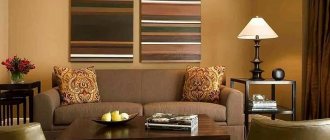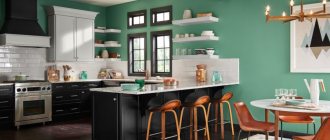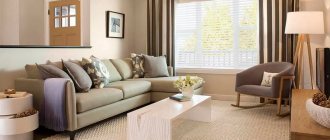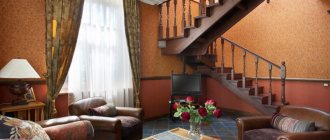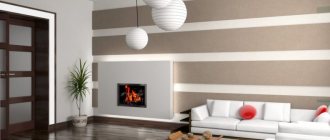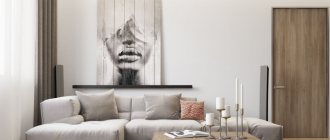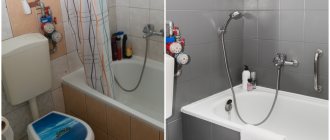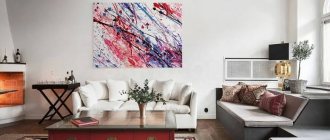The living room is rightfully considered the center of the apartment and house, since it is here that family and friends gather for rest and relaxation after a working day. For a good mood, relief from nervous tension and complete distraction from everyday life, the color of the walls in the living room is selected taking into account a number of rules used by professional designers around the world.
Features of choice
A correctly selected color scheme can visually make a room larger and more spacious, fill it with light, support the overall concept, and even eliminate some of the shortcomings of the room.
Criteria for color selection
- Features of lighting. Dim lighting can be corrected by using bright, light palettes that distribute light evenly and eliminate dark corners. If natural light enters the room in sufficient quantities or even in excess, preference should be given to cool, calm tones.
- Design and personal preferences. First of all, the color of the living room should be liked by its owners. In addition, if a certain style concept has already been chosen in a design project, it must be adhered to.
- Functionality requirements. The color of the finish can often act as a tool for zoning space instead of massive partitions or furniture groups.
- Living room area. A spacious room opens up more opportunities for realizing bright ideas. Here you can create a contrasting finish, or use smooth transitions. Small living rooms require the use of light colors and neat accents that will harmonize with other interior details.
Not all walls have to be painted the same tone, but there should be balance in everything. The finishing of the floor and ceiling is pre-thought out so that all surfaces fit well together.
Preparation
Before painting, it is necessary to prepare the surface. This is the most important stage, since the result depends on the quality of the preparatory work. This is especially true for the living room, where all the flaws are immediately evident.
Preparation is carried out in several stages:
- It is necessary to clean the surface of old coating, protruding pieces of cement and small irregularities.
This can be done with a wide spatula, sequentially processing each area. Attention: If there are large chips, blockages or holes on the surface, they need to be additionally plastered. - Priming the base. You will need a roller. To speed up the work, you can use a special construction sprayer.
- Lifting corners to give them visual evenness.
- Apply finishing polymer putty to the base in 2 layers. First, you need to apply the first one, wait until it dries completely, remove small bumps and irregularities with a spatula, and then proceed to apply the second layer. Read about how to putty and evenly paint walls here.
- Then you need to clean the putty surface with sandpaper (No. 150).
- Next, the surfaces are primed again, and fiberglass is glued on. The material hides any surface imperfections, protects against the appearance of microcracks, prevents the development of mold, and allows the walls to “breathe.”
- When the fiberglass has completely dried, you need to begin applying the final coating - superfinish putty (2 layers). Thanks to this material, the wall can be given a perfectly flat surface. An important condition for using superfinish putty is high-quality preparation of the base.
- The final stage is cleaning the surfaces with sandpaper No. 240. After sequentially performing all the described actions, you can begin applying paint.
Influence on the choice of cardinal directions
Any palette can manifest itself differently depending on the degree of natural light. This factor depends not only on the size of the window openings and their openness, but on the side of the world from which the room is located.
- South. Often there is not only enough sunlight, but also in excess. In order to reduce the “temperature”, it is recommended to use moderately cool shades (white, blue, turquoise, gray).
- West. During the daytime peaks, the room may be too hot and light, so there should be cool shades, such as mint (closer to blue), deep blue, gray, brown.
- East. It is recommended to give preference to pink and brown tones, which will benefit from the sunrise and compensate for its lack in the afternoon.
- North. Due to the coldness and short duration of sun hours, you need to choose warm, soft shades (beige, coffee, green, yellow). They will not only add light to the room, but also visually fill it with sun.
Before choosing the color of the walls for the living room, you need to consider the location and intensity of the lighting fixtures. If they are located around the entire perimeter of the room (in the form of LEDs or built-in lamps), the tint palette can be changed depending on the desired effect.
Choosing the color of the walls in the living room: beautiful combinations, the best colors for the living room
The choice of living room color depends on many factors, from the style used to the location of the room relative to the cardinal directions. In addition, a number of other factors play a role:
- Room area.
- Quality of artificial and natural lighting.
- Owner preferences.
- Practical requirements.
Living room with gray walls Source uutvdome.ru
Wall color in the living room located on the south side Source dizainexpert.ru
Sand-colored wallpaper Source rehouz.info
Healthy! When choosing colors for decorating your living room interior, you can use Itten’s color wheel. If you understand its principles, you can make it the main design tool.
It is recommended to decorate small living rooms in light colors. With their help, a visual increase in space is achieved. A good solution would be to add additional decor to one of the walls. For rooms with a larger area, there are more options for a wild design idea. The color background is smooth or contrasting.
The living room windows, “looking” towards one of the cardinal directions, have a significant impact on the interior of the living room. The saturation of sunlight or its absence influences the choice of color:
- For a “northern” living room, it is advisable to use soft, warm tones. They will compensate for the lack of sun. An excellent solution would be yellow, green, beige and chocolate shades.
- “Southern” living rooms are often decorated with cool colors. Sky blue, turquoise and white tones would be a good option.
- Windows facing east are the first to greet the rays of the rising sun. To enhance the effect, you should opt for warm, light colors (pale pink, chalky, peach).
- “Western” living rooms are decorated with cool colors (shades of blue, mint, neutral gray).
Living room with wallpaper of a single color Source www.remontbp.com Living room with “warm” walls Source modernplace.ru
The correctly selected color of the living room walls performs several functions at once:
- Reduces or increases the area of the room.
- Highlights the required zones.
- “Cools” or “warms” the space.
- “Expandes” or “narrows” the walls of the living room.
- Visually increases the height of the ceilings.
- Gives the living room depth and volume.
Combination of beige and gray colors Source pinimg.com
Choosing the color of the walls in a Scandinavian style living room Source pinimg.com
Healthy! Saturation or darkening produce the opposite impression and can make the room look completely different.
Calm pink background Source dizajn-gostinoj.com
Feng Shui in the color scheme of the living room
The use of Eastern teachings when choosing interior colors allows you to determine the direction of vibration and energy, which will have a positive effect on a person’s mental and physical health. The teaching is based on the basic elements: Wood, Fire, Metal, Water and Earth. In this case, the finishing should be placed on smooth, even walls so that nothing interferes with the movement of positive energy.
Characteristics of Feng Shui flowers
- White. Symbolizes ideal, purity, light. For comfort and warmth, use in combination with another palette. An excellent solution is to add yellow tones.
- Red. The color of passion, activity, movement. It stimulates the appetite, but can sometimes cause attacks of aggression. When combined with gold, it attracts good luck. Red doesn't go well with black. The palette is not recommended for use by people with diseases of the nervous system.
- Orange. Combines the positive energy of yellow tones and the power of red. Conducive to a pleasant conversation in the guest room, attracts prosperity and kindness.
- Gold. Denotes respect, honor, status. Previously, only rulers could use this color in the interior. The golden palette has a positive effect and attracts money energy.
- Black. In fact, it is not considered a mourning color, but a magical color according to Chinese teachings. But many still equate it with negativity, so it is better to minimize the use of black or use it for accents.
- Blue. The main association is water. The palette has a calming effect, restores harmony, relaxes and is suitable for meditation. Blue stimulates spiritual energy and intuition.
- Green. The color of calm, peace, nature. It stimulates wealth and well-being, means life, growth, harmony with others. Pairs well with yellow and gold colors, creating the energy of success.
- Yellow. Symbolizes positive energy, success, happiness. It attracts warmth and makes the living room cozy, evokes an optimistic mood, and attracts good luck.
- Violet. It has mystical, magical properties. Suitable for creative people, symbolizes material well-being.
When choosing not one, but several wall colors in the living room interior, it is important that they indicate one direction to enhance energy. You should be guided not only by the above characteristics, but also by your own preferences in order to create a cozy interior.
Types of compositions that can be used in interior design
There are enough paints in stores on different bases that can be used in residential areas. There are quick-drying compositions with a glossy and matte surface, as well as decorative mixtures that, when applied in several layers, can transform the interior beyond recognition.
Manufacturers offer paints in the form of a white base, which can be tinted in any color, or ready-to-use compositions in a wide palette of shades.
Types of paints that are used:
- Alkyd . The coating is used on any substrate, does not deteriorate in conditions of variable and high humidity and can be used in any room.
- Oily . It is made on the basis of drying oil, which takes a long time to dry and emits an unpleasant odor. Rarely used for indoor use on walls, but will work great outdoors.
- Enamel . It is made on a varnish base, which gives a characteristic shine when dried. The composition dries quickly and when used on walls, it creates a durable coating that is not afraid of water and mechanical damage.
- Acrylic. Designed for walls and ceilings in dry rooms. The composition has excellent value for money. Acrylic paint lends itself well to tinting and will retain its color for the entire period of use.
- Latex. Used in rooms with high humidity and in the kitchen. The coating does not allow water to pass through and washes well, does not absorb dirt and odors, but is prone to fading in the sun.
- Water-based. The paint can be tinted well in any color, applied and creates a durable coating that can hide minor defects. Disadvantages include loss of color saturation during operation.
- Silicone. The composition is safe and, when applied, creates a durable film that is easy to clean and repaint if necessary. Silicone paint is compatible with most compositions on other substrates and does not require careful surface preparation.
Any of these coatings can be used in residential areas and are safe after drying. The main thing when choosing a decorative coating is to take into account the conditions of use. When painting walls in rooms with variable humidity, water-based paints are not recommended.
Optimal solutions
Gray background
A modern, popular palette that is suitable for both classic and loft, minimalism, and modern styles. For greater effect, it is complemented with geometric textures. Thanks to the variety of shades, it is suitable for rooms of different sizes.
Yellow scale
When choosing, you should pay attention only to pastel and calm shades, and not bright and flashy shades, which will negatively affect your relaxation and cause nervous tension. Sunny, warm yellow is associated with summer and comfort. In spacious rooms it can be used for all walls, in small living rooms - for interesting accents in decor, photos, etc.
Brown tones
Mainly used for classic solutions. More saturated and deeper shades are chosen for accents, coffee, chocolate, etc. for the background.
Olive shade
Well suited for Provence, Scandinavian style, country. A soft, natural, pastel shade of green is suitable for rooms of different sizes and locations. The noble tone gives coziness and comfort and goes well with other soft tones.
Light orange
Associated with rich summer colors. It is used for various interior solutions and will become the highlight of a mixed style of classic and modern. Pairs well with turquoise and gray. Looks good in dark living rooms with windows facing north. It also compensates for the lack of lighting.
Shades of beige
A popular, versatile, practical color that can be used to decorate any living room. The room will be warm and harmonious. For decoration, bright, rich colors, imitation brickwork, and textured plaster are used.
Shades of turquoise
The turquoise palette will give you a feeling of freshness, freedom, and spaciousness. The shades are presented both rich and deep, and pastel, fresh. It goes well with different color options without overloading the interior. Makes a cool palette softer and more appropriate. More suitable for spacious rooms, plays well as accents.
Natural shades of green
A natural, comfortable palette that symbolizes life. Various shades are used in the living room interior. Often gamma is used to zoning space. Pairs well with shades of gold, brown, and floral prints.
White background
Strict and restrained, but at the same time, a neutral color that can be used as a base for any style. Its color palette is wide and varied, and textured application will open up new facets of white. The palette visually expands the room, fills it with light and warmth, and eliminates dark corners.
Painting walls with a roller with a pattern
To decorate a wall with an individual repeating pattern, you will need a special roller. It can be purchased at a hardware store or made by hand using a clipper (artistic skill required). Simply dip the tool in the paint coating and run it along the wall. Make sure that the layer is sufficient, otherwise the pattern will gradually fade.
Decorating a wall with images using a double roller Source dekordelisi.com
Rollers with such attachments are sold separately.
Different attachments for the roller with a pattern Source oshtukaturke.ru
Selecting one wall with “honeycombs”
Honeycomb painting will help highlight the interior and make it unique. It can be done using a pre-drawn template. Many people first prepare the surface: create a pattern using adhesive tape, and then start painting. It is better to make such patterns multi-colored, alternating light with dark tones. Amber from top to bottom is allowed.
Painting walls with a honeycomb design Source etsy.com
Complex geometry
Geometric shapes with many shapes are best used for one wall. Since very often mistakes are made during the continuation of patterns on partitions: the seams are deformed, the size is distorted. To organize a colorful ornament, you need to paint one by one. Draw figures and wait for them to dry. Next, apply the next part of the composition.
Geometric multi-colored pattern on the entire wall Source pinterest.ru
Paint drips
To imitate long drops, you will need a thick syringe and paint that matches the color of the interior. Start your composition from the ceiling. Fill the syringe with paint and release it onto the wall using gentle pressure. There is no need to adhere to symmetry here. You can dilute a certain amount of smudges with a color of the opposite shade.
Imitation of paint drips in a modern interior Source obzor-review.blogspot.com
Circles in the interior
A dark background and bright multi-colored circles will add grace and contrast to the room. Usually this design is carried out in the sofa area. This makes it possible to concentrate attention on the recreation area. The design turns out interesting if the circles are designed in the form of connected rings.
Circles on a gray wall background Source prueba.negociostec.org
Immerse yourself in a nautical theme
Decorating a bathroom requires attention. It is not enough to simply paint the walls in a room. They can be diversified with marine life and algae. If it is not possible to make the drawing yourself, use cardboard templates. It is advisable to create sketches in the sink or bathroom area. It is also acceptable on the side wall near the toilet.
A marine theme is a good idea for painting bathroom walls Source bringly.ru
Characteristic stylistic palettes
- Contemporary. Modern style allows you to use more bright colors such as blue, turquoise, emerald, lilac, etc. A combination of several contrasting colors in one room is typical.
- Scandinavian. The style is characterized by the use of beige, gray and white tones, as well as shades of blue. The color should be harmonious and maintain spaciousness.
- Classic solutions. These directions are characterized by muted, calm colors of brown, green, and blue. Only one shade is used in the interior; patterned wallpaper is used for accents.
- Loft. A modern solution for decorating a living room. Mainly cold, calm tones are used for the interior. Gray and white go well with brick. For such an “industrial” idea, you can use black.
- Country. A rustic theme is impossible without natural shades such as brown, green, soft yellow, blue, peach, olive, etc.
- Provence. The base is pastel colors such as olive, beige, lavender, etc. It has a natural, restrained palette.
The palette of each style may vary depending on the functional purpose of the color, the area of the room, and personal preferences. If, according to the design project, the implementation of non-standard tones is appropriate, there are no restrictions for bringing such an idea to life.
How can you wash painted walls?
When starting to wash the walls, it is important to consider what material they are covered with. After all, a specific type of paint must have its own care:
- Do not wash walls coated with oil-based paint with soda or soap. Small stains can be easily cleaned with a regular eraser. The entire wall is washed with water and starch no more than 2 times a year;
- For all types of paints, you cannot use any alcohol or alcohol-containing substances;
- You can wash the surface with water and diluted vinegar (300 ml of household vinegar per bucket of water);
- For washable paint, mildly alkaline cleaning agents are used. Walls can only be cleaned with soft material. The same applies to water-based paints.
For washable paint, mildly alkaline cleaning agents are used.
Painted walls will always be relevant in any room and design. They can be combined with different furniture and other finishing materials. Painted walls will complement any interior and make the room even more comfortable.
Types of color combinations
- Contrast. This color combination is used to implement modern interiors. You can choose the most unexpected colors if you place them correctly in the room. Use options - accent wall, geometric patterns, stained glass or panel effect, etc.
- Neutral combination. Opens up ample opportunities for the implementation of original ideas. Delicate shades are suitable for classics, for modern solutions - cooler palettes.
- Monochromy. The use of one color scheme allows not only to visually preserve the area, but also to expand it. There are many combinations, since each color can have dozens of shades. Without overloading the interior, you can zone the space.
- Two colors. The use of two different colors is acceptable for spacious rooms, but other solutions can be considered if both shades are light. It is important that the colors chosen are from one half of the spectrum. The transition is smooth, the gradient method is popular.
The use of several combinations is possible only if the living room area is 25 square meters or more. Then one of the zones can be decorated for relaxation in soothing colors, the other can be decorated for receiving guests, etc.
Mistakes when painting house walls
When painting walls, some difficulties and mistakes arise. Among the most common are the following:
- Unprepared surface. Such walls cannot be painted. The coating will quickly begin to crack and crumble.
- Painting a wall without primer. The most common mistake. As a result, the facing material does not fit well and begins to roll or collect debris.
- The paint is not thinned correctly. It is very easy to overdo one color when mixing. The result is a defect in interior design.
- One layer application. This option is usually not acceptable. Of course, if there is no need to create translucent styles in decoration.
- Re-painting over a non-dried layer. Such a mistake often spoils the beauty of the chosen color or pattern. Fixing a defect is very difficult.
Neat transition of tone along the wall Source designelena.jimdo.com
Choosing colors for a small living room
To decorate a small living room, light, calm colors are used that will be in harmony with other interior elements. It is better to avoid patterns and prints, as they may make the room seem smaller. Decorative items and furniture are used for bright accents.
To visually enlarge the room, you need to think about a lighting scheme that will highlight the color of the walls, and also hang mirrors. If you use wallpaper or decorative plaster, they should be discreet, monochrome, without unnecessary details that could negatively affect the visualization of the space. An interesting solution could be to paint an accent wall in a different shade, if you choose the right color.
Advantages and disadvantages of painted walls
It seems that painted walls are the simplest finishing option. However, they have their own positive and negative features that are worth remembering. The main advantages of painted surfaces are:
- The modern building materials market offers a huge range of paint and varnish coatings for walls, differing in quality characteristics, purpose and shades;
- When the paint dries, it does not emit toxic chemical gases and does not harm human health in any way;
- You can do the painting yourself;
- It is possible to decorate painted surfaces with special patterns or using a special roller with a convex pattern.
Among the disadvantages of painted walls are:
- Before starting work, the master must prepare the walls well;
- The paintwork on the walls highlights differences and other imperfections;
- If fresh painting is planned, the old layer will need to be cleaned off.
It is possible to decorate painted surfaces with special patterns or using a special roller with a convex pattern.
Photo gallery
Our gallery features photographs of completed projects demonstrating the correct use of color for living room walls.
